By Marc Ornstein
For purposes of this article, I am referring to narrow, generally twisty, fast to moderately moving streams (such as one might find in the NJ Pine Barrens). I am not referring to large rivers and or whitewater although many points may apply.
1st – A few safety related issues. This is not a comprehensive list but covers some items specific to the topic of this article.
- One should always wear a life jacket; fully zipped/buckled according to the manufacturer’s directions. If the air and or water temperatures are cold, one should wear a dry suit or wetsuit or at a minimum, have a full set of spare clothing in a dry bag.
- One should always carry a spare paddle. It’s not uncommon for a paddle to get dropped, broken or lost.
- Bow & stern lines are a must. Twelve to fifteen feet seems to be a good length, allowing for plenty of reach yet not so long as to get easily tangled.
- Beware of strainers:

Strainers are blockages, generally formed by tree limbs and other debris that allow water to pass through, over, or under but will not allow large, solid objects to pass. In this case the solid objects are you, your canoe and likely your gear. Water pressure, caused by the current flow can pin you and your boat to the strainer. The forces can be immense. People are often unable to free themselves from strainers and thus drown. Canoes and other craft are often severely damaged or destroyed by the pressure. Strainers can be deadly and must be approached with the utmost caution or avoided altogether.
-

No Tailgating! Don’t tailgate. Leave plenty of space between your canoe and the one ahead of you. Crashing into the boat ahead, when it slows to maneuver or stop is bad form and can lead to a dangerous situation.
Safely and gracefully navigating these streams requires specific skills and for the paddler to be constantly proactive. By proactive, I mean to recognize river features and hazards well before reaching them and then positioning the canoe so as to easily maneuver past or around them. Too often, folks wait until the last minute, then flail around with awkward sweeps or extreme pries. They attempt to shove off or worse grab onto tree limbs or other stationary objects in their last ditch attempts at avoidance. Such actions commonly result in capsized or pinned canoes. Even when there is no clear path, a good/proactive setup can align the canoe properly for a safe lift over or takeout.

The ability to “read” the water is essential. The skilled paddler is constantly studying/analyzing the currents ahead so as to predict their effects on the canoe rather than waiting until he or she is being shoved this way or that by them. One could take advantage of the faster current, going around the outside of a bend but at the risk of being pushed into the brush along the shoreline. Perhaps a safer route would be the inside of the bend where the current is slower but the water might also be shallow. Allowing the bow to enter a slow or eddy current, along the shore, while the stern is still out in swift water, near the center of the stream, may cause the canoe to spin around so that it is now heading downstream, backwards. All these factors and many more are constantly changing and adapted to by paddlers with the necessary skills.
Useful Maneuvers:
- Side Slips

Without any doubt, this is the most useful and frequent maneuver that I use. The basic sideslip (drawing or prying) moves the canoe laterally across the stream without turning. I use it to slide past obstructions, stay away from the shoreline when the current is pushing me towards it, position myself for a clear slot and a myriad of other things.
- Variants of the side slip include cross side slips, loaded side slips and compound loaded side slips. Side slips can be static, in that the paddle is held in a stationary position while the movement of water past it creates the necessary drawing or prying pressure, or they can be dynamic in which case the paddle is “sculled” to create the pressure against it.
- Wedges
Wedges deflect the bow (stern when moving in reverse) away from the paddle side. They are an efficient way to turn in that direction without accelerating, as would occur with a sweep.
- A variant is the cross wedge.
- Stern pries and draws
Stern pries and draws push the stern away from or draw it toward the paddle. They are additional options for turning, without acceleration. By appropriately loading the blade (leading edge turned out on the draw or in on the pry) one can simultaneously slow the canoe.
- Back paddling
Back paddling slows or stops the canoe and buys you time: Time to plan your next move, or to space out from the boat in front of you. Generally, the current provides most of the necessary speed. What the paddler needs is control.
These are just some of the techniques that we teach at the Pine Barrens Functional Freestyle Canoeing Workshop each fall (https://freestylecanoeing.com/pine-barrens-2/). They are adaptations of the various maneuvers that are taught at all FreeStyle Symposiums.